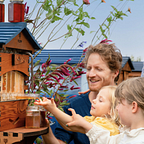Varroa Mites Natural Treatment: How To Treat Varroa Mites Organically
Varroa mites pose a significant threat to honeybee colonies, impacting bee health and overall hive productivity. For beekeepers committed to organic practices, finding effective and sustainable methods for treating Varroa mites is crucial. In this guide, we will explore organic beekeeping strategies to combat Varroa mites naturally while maintaining the health and vitality of your bee colonies.
Varroa mite outbreak in beehives is surely a big problem. Many novice beekeepers lose their hives but Varroa mites infestations can be easily controlled without destruction of the hive itself. More on how to do this below.
How Varroa Mites Infestation Affect Bee Health
Originating from Asia, these mites have become a global threat to honeybee populations. They primarily feed on the bodily fluids of adult bees and their developing brood, weakening the overall hive health. Mites weaken adult bees, leading to decreased foraging and compromised immune systems. Furthermore, infested brood may suffer deformities, reduced longevity, and increased susceptibility to diseases. If not effectively managed, Varroa mites can cause colony collapse, posing a severe threat to beekeepers and pollination-dependent ecosystems.
Signs of Varroa Infestation:
Beekeepers need to be vigilant in identifying signs of Varroa mite infestation. Indicators include;
- Deformed wings in adult bees
- Abnormal pupae
- Higher incidence of weakened or dead bees near the hive entrance.
Regular monitoring and early detection are crucial for effective Varroa mite management.
Varroa Mites Natural Treatments
Beekeepers committed to organic practices have an array of natural methods at their disposal for managing Varroa mite infestations. These methods not only prioritize the health of honeybee colonies but also align with environmentally conscious principles. Let’s explore some effective organic treatment options:
- Powdered Sugar Dusting:
- Method: Sprinkling powdered sugar over the bees prompts them to groom each other, dislodging Varroa mites in the process.
- Benefits: Organic, simple, and cost-effective.
- Considerations: Requires regular application.
Powdered sugar dusting is a simple yet effective method for Varroa mite control in organic beekeeping. Beekeepers lightly dust their colonies with powdered sugar, encouraging mites to fall off due to their inability to cling to the bees’ bodies. This process mimics natural grooming behavior and provides a non-toxic means of reducing mite populations. Regular applications, especially during the brood-rearing season, can significantly impact mite levels.
2. Essential Oils:
- Method: Thyme and wintergreen essential oils possess mite-repelling properties when applied to hives.
- Benefits: Natural, aromatic, and can contribute to overall hive health.
- Considerations: Dilution and proper application are crucial.
Essential oils, such as thyme and wintergreen, offer natural alternatives for Varroa mite treatment. These oils possess inherent properties that can disrupt mite infestations without harming the bees. Beekeepers can create formulations or use pre-existing essential oil products specifically designed for Varroa control. When applied correctly, essential oils contribute to organic mite management while promoting a positive environment within the hive.
3. Screened Bottom Boards:
- Method: Hive bottom boards with screens allow mites to fall through, reducing their population.
- Benefits: Mechanical and non-invasive.
- Considerations: Requires proper hive ventilation.
Installing screened bottom boards enhances ventilation in the hive and provides a physical mechanism for mite control. Varroa mites fall through the screen, reducing their chances of re-infesting the colony. This method is an integral part of integrated pest management (IPM) and aligns with organic principles by utilizing natural hive dynamics for mite reduction.
4. Oxalic Acid and Formic Acid:
- Method: Organic acids, like oxalic and formic acids, can be used for mite control.
- Benefits: Naturally occurring acids with proven efficacy.
- Considerations: Careful application to avoid harm to bees.
Organic acids, such as oxalic acid and formic acid, are approved for use in organic beekeeping when applied judiciously. These acids can effectively control Varroa mites without leaving harmful residues in hive products. Proper application methods, following organic standards, make these acids valuable tools for beekeepers seeking eco-friendly Varroa control options.
Adopting Modern Hive Management Practices and Bee Health
In my journey as a beekeeper dedicated to organic practices, I once found myself at a crossroads, seeking effective yet natural solutions for Varroa mite control. Frustrated with the limitations of conventional methods, I stumbled upon a wealth of knowledge that transformed my approach to hive management.
By embracing the principles outlined in “Modern Eco-friendly Hive Management and Bee Health” manual, you’re not just investing in knowledge; you’re joining a community of environmentally conscious beekeepers dedicated to the well-being of their hives and the preservation of our pollinator populations. Discover the joy of sustainable beekeeping and the satisfaction of nurturing healthy, thriving bee colonies.
